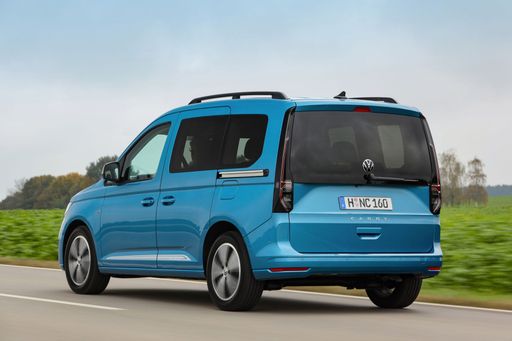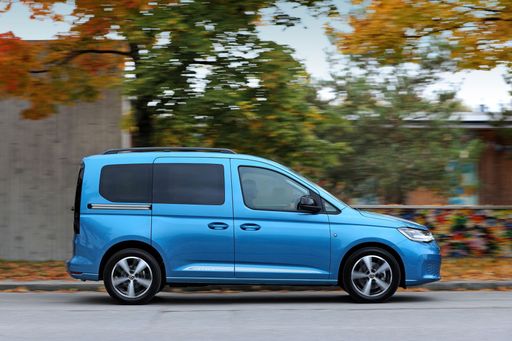VW Caddy vs Kia PV5 – Differences & prices compared
Both models have their strengths – but which one suits you more?
Compare performance, efficiency, price and space directly: VW Caddy or Kia PV5?
Here’s where it gets real: The technical differences in detail
Costs and Efficiency: Price and efficiency are key factors when choosing a car – and this is often where the real differences emerge.
VW Caddy has a a touch advantage in terms of price – it starts at 27800 £, while the Kia PV5 costs 32800 £. That’s a price difference of around 5061 £.
As for range, the Kia PV5 performs strongly better – achieving up to 400 km, about 279 km more than the VW Caddy.
Engine and Performance: Power, torque and acceleration say a lot about how a car feels on the road. This is where you see which model delivers more driving dynamics.
When it comes to engine power, the Kia PV5 has a minimal edge – offering 163 HP compared to 150 HP. That’s roughly 13 HP more horsepower.
In acceleration from 0 to 100 km/h, the Kia PV5 is barely noticeable quicker – completing the sprint in 10.70 s, while the VW Caddy takes 11.40 s. That’s about 0.70 s faster.
In terms of top speed, the VW Caddy performs clearly better – reaching 186 km/h, while the Kia PV5 tops out at 135 km/h. The difference is around 51 km/h.
There’s also a difference in torque: the VW Caddy pulls clearly stronger with 320 Nm compared to 250 Nm. That’s about 70 Nm difference.
Space and Everyday Use: Whether family car or daily driver – which one offers more room, flexibility and comfort?
Seats: VW Caddy offers clearly more seating capacity – 7 vs 5.
In curb weight, the VW Caddy is slightly lighter – 1575 kg compared to 1860 kg. The difference is around 285 kg.
In maximum load capacity, the Kia PV5 performs somewhat better – up to 4420 L, which is about 720 L more than the VW Caddy.
When it comes to payload, Kia PV5 slightly takes the win – 790 kg compared to 710 kg. That’s a difference of about 80 kg.
All in all, the Kia PV5 shows itself to be wins this duel convincingly and secures the title of DriveDuel Champion.
It impresses with the more balanced overall package and proves to be the more versatile companion for everyday use.
VW Caddy
The VW Nutzfahrzeuge Caddy Hochdach-Kombi is a versatile choice for those seeking extra space and practicality in their everyday vehicle. With its functional high roof and adaptable interior, it easily accommodates both passengers and cargo. The Caddy also stands out with its modern design and features aimed at providing comfort and convenience on the road.
details @ vwpress
@ vwpress
 @ vwpress
@ vwpress
 @ vwpress
@ vwpress
 @ vwpress
@ vwpress
Kia PV5
The Kia EV5 is an exciting new entrant in the landscape of electric SUVs, promising a blend of style and innovation that captures attention. It boasts a sleek and modern design that aligns with Kia's evolving aesthetic identity, blending practicality with eye-catching details. With its foray into the electric vehicle segment, the EV5 is set to offer a highly competitive option for those looking to embrace sustainable mobility without compromising on comfort or tech features.
details

|
|
|
|
|
Costs and Consumption |
|
|---|---|
|
Price
27800 - 45900 £
|
Price
32800 - 38900 £
|
|
Consumption L/100km
0.5 - 6.9 L
|
Consumption L/100km
-
|
|
Consumption kWh/100km
-
|
Consumption kWh/100km
19.8 - 20.3 kWh
|
|
Electric Range
116 - 121 km
|
Electric Range
288 - 400 km
|
|
Battery Capacity
19.70 kWh
|
Battery Capacity
51.5 - 71.2 kWh
|
|
co2
10 - 165 g/km
|
co2
0 g/km
|
|
Fuel tank capacity
50 L
|
Fuel tank capacity
-
|
Dimensions and Body |
|
|---|---|
|
Body Type
High Roof Estate
|
Body Type
Cargo Van, Bus
|
|
Seats
5 - 7
|
Seats
2 - 5
|
|
Doors
5
|
Doors
4 - 5
|
|
Curb weight
1575 - 1998 kg
|
Curb weight
1860 - 2145 kg
|
|
Trunk capacity
-
|
Trunk capacity
1320 L
|
|
Length
4500 - 4853 mm
|
Length
4695 mm
|
|
Width
1855 mm
|
Width
1850 - 1895 mm
|
|
Height
1819 - 1860 mm
|
Height
1923 mm
|
|
Max trunk capacity
2556 - 3700 L
|
Max trunk capacity
2300 - 4420 L
|
|
Payload
501 - 710 kg
|
Payload
505 - 790 kg
|
Engine and Performance |
|
|---|---|
|
Engine Type
Petrol, Diesel, Plugin Hybrid
|
Engine Type
Electric
|
|
Transmission
Manuel, Automatic
|
Transmission
Automatic
|
|
Transmission Detail
Manual Gearbox, Dual-Clutch Automatic
|
Transmission Detail
Reduction Gearbox
|
|
Drive Type
Front-Wheel Drive, All-Wheel Drive
|
Drive Type
Front-Wheel Drive
|
|
Power HP
102 - 150 HP
|
Power HP
121 - 163 HP
|
|
Acceleration 0-100km/h
11.4 - 14 s
|
Acceleration 0-100km/h
10.7 - 16.3 s
|
|
Max Speed
173 - 186 km/h
|
Max Speed
135 km/h
|
|
Torque
220 - 320 Nm
|
Torque
250 Nm
|
|
Number of Cylinders
4
|
Number of Cylinders
-
|
|
Power kW
75 - 110 kW
|
Power kW
89 - 120 kW
|
|
Engine capacity
1498 - 1968 cm3
|
Engine capacity
-
|
General |
|
|---|---|
|
Model Year
2024
|
Model Year
2025
|
|
CO2 Efficiency Class
E, F, B
|
CO2 Efficiency Class
A
|
|
Brand
VW
|
Brand
Kia
|
Is the VW Caddy offered with different drivetrains?
Available configurations include Front-Wheel Drive or All-Wheel Drive.
The prices and data displayed are estimates based on German list prices and may vary by country. This information is not legally binding.
